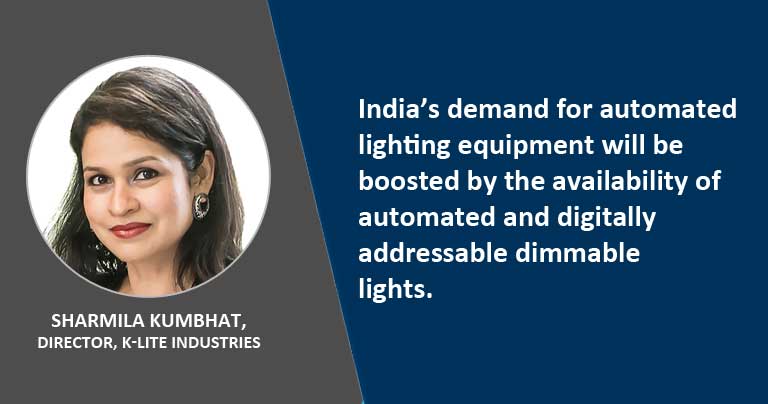Facilitating smart opportunities with advanced smart lighting
By EPR Magazine Editorial November 14, 2021 10:30 am IST
By EPR Magazine Editorial November 14, 2021 10:30 am IST

Sharmila Kumbhat, Director, K-Lite Industries in an interview with EPR Magazine.
With the government’s plan to have 100 smart cities in India, how do you view the demand for smart and efficient lighting in commercial and residential segment?
Globally, lighting as an industry is growing at an alarming pace with projected value of around US$ 2000 million. This decade is going to witness phenomenal changes in the field of lighting. The last decade’s thrust was energy-saving measures, which gave rise to the LED lighting to replace all other conventional lighting. Application of solid-state devices as a source of lighting has given way to new concepts in lighting control and automation. Gone are the days when our options were just limited to the lighting with GLS lamp or FTL lamp with just one off control. Now, the general public are well informed and have started prescribing the lumen requirements, watt per lumen, lighting control, and above all IOT (Internet of things) compliance etc., The order of the day is smart (green) concept in every field viz., smart home, smart city, smart pole, smart lighting , etc. With regard to lighting, smart lighting is a lighting technology designed for energy efficiency. This may include high-efficiency fixtures and automated controls that make adjustments based on conditions such as occupancy or daylight availability through lighting control system with an intelligent networked system of devices. These devices may include relays, occupancy sensors, photocells, light control switches or touch-screens, and signals from other building systems.
With the government’s plan to have 100 smart cities in India, the demand for smart and efficient lighting in commercial and residential segment is going to be a major challenge. The availability of automated changes with the digitally addressable dimming interface, drivers with CCT tuning capability and many other devices, will drive the consumers in smart cities to demand for automated changes in lighting levels to affect mood, emphasise architecture, illuminate art, and influence action.
How are IT, IIoT and automation enabling the industry to meet the demand of energy efficient lighting for smart cities?
Smart cities use Internet of Things (IoT) devices such as sensors, lights, and meters to collect and analyse data. The cities then use this data to improve infrastructure, public utilities and services, and more. Smart cities ensure that their citizens get from point ‘A’ to point ‘B’ as safely and efficiently as possible. IOT usage has facilitated for (a) Smart parking (b) Smart street lighting control, (c) waste management, etc.Transformation of all cities (Tier 1 and Tier 2 to start with) has potentially increased bulk orders to the manufacturers and in particular the lighting business and the demand are expected to grow fast in the years to come.
How is the lighting sector contributing in cutting down the environmental impacts and CO2 emissions?
It is only after energy crisis/global warming due to various factors including environmental degradation etc., and the absolute need for energy saving measures were tightened, the possibility of substituting LEDs as a light source in the place of conventional sources like mercury vapour/SV/MH/FTL/CFL lamps etc., was thought of. With LED-lighting we eliminate the pollution caused due to mercury in the conventional lamps, reduction of power demand (for getting the same light output from conventional sources) and thereby reduction of carbon emission in coal-based power generation and above all, saving of natural resources which are being exploited disproportionately causing ecological imbalance.
Ecological balance ensures the stability of the organisms and environment. How the excessive uncontrolled artificial lighting known as light pollution contributes to the ecological balance is being highlighted everywhere. Light pollution is excessive, misdirected, or obtrusive artificial (usually outdoor) light. Too much light pollution has consequences; it washes out starlight in the night sky, interferes with astronomical research, disrupts ecosystems, has adverse health effects and wastes energy. Research on insects, turtles, birds, fish, reptiles, and other wildlife species shows that light pollution can alter behaviours, foraging areas, and breeding cycles. In disrupting ecosystems, light pollution poses a serious threat in particular to nocturnal wildlife, having negative impacts on plant and animal physiology. It can confuse the migratory patterns of animals; alter competitive interactions of animals, change predator-prey relations, and cause physiological harm. The main causes of light pollution are (A) Poor Planning. (B) Excessive Use of Light. (C) Streetlamps, (D) Light From Houses and Garage Lamps, and (E) Night time-lighting. It is in such a context that LED luminaires with digital controls have all the provisions for a controlled environment and reduce/eliminate light pollution.
We use cookies to personalize your experience. By continuing to visit this website you agree to our Terms & Conditions, Privacy Policy and Cookie Policy.